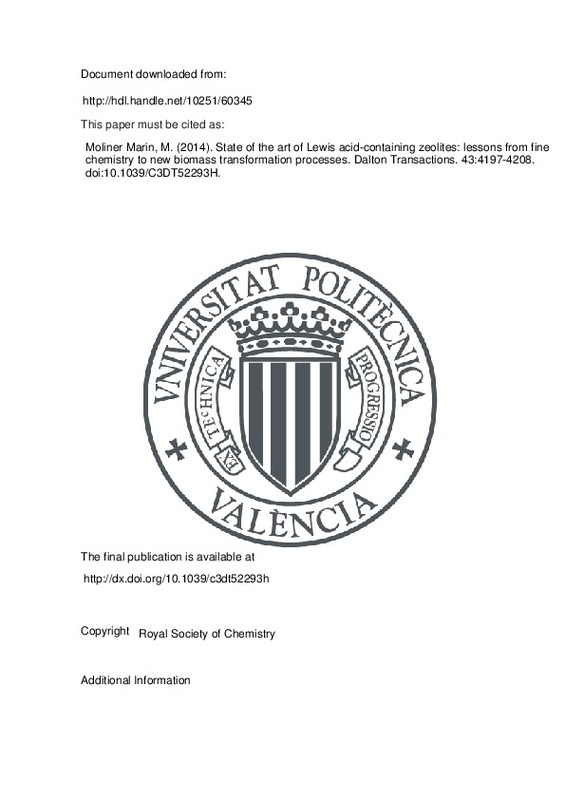JavaScript is disabled for your browser. Some features of this site may not work without it.
Buscar en RiuNet
Listar
Mi cuenta
Estadísticas
Ayuda RiuNet
Admin. UPV
State of the art of Lewis acid-containing zeolites: lessons from fine chemistry to new biomass transformation processes
Mostrar el registro sencillo del ítem
Ficheros en el ítem
| dc.contributor.author | Moliner Marin, Manuel
|
es_ES |
| dc.date.accessioned | 2016-01-29T08:09:14Z | |
| dc.date.available | 2016-01-29T08:09:14Z | |
| dc.date.issued | 2014 | |
| dc.identifier.issn | 1477-9226 | |
| dc.identifier.uri | http://hdl.handle.net/10251/60345 | |
| dc.description.abstract | [EN] The former synthesis of TS-1 opened new catalytic opportunities for zeolites, especially for their application as selective redox catalysts in several fine chemistry processes. Interestingly, isolated Ti species in the framework positions of hydrophobic zeolites, such as high silica zeolites, offer unique Lewis acid sites even in the presence of protic polar solvents (such as water). Following this discovery, other transition metals (such as Sn, Zr, V, Nb, among others) have been introduced in the framework positions of different hydrophobic zeolitic structures, allowing their application in new fine chemistry processes as very active and selective redox catalysts. Recently, these hydrophobic metallozeolites have been successfully applied as efficient catalysts for several biomass-transformation processes in bulk water. The acquired knowledge from the former catalytic descriptions in fine chemistry processes using hydrophobic Lewis acid-containing zeolites has been essential for their application in these novel biomass transformations. In the present review, I will describe the recent advances in the synthesis of new transition metal-containing zeolites presenting Lewis acid character, and their unique catalytic applications in both fine chemistry and novel biomass-transformations. | es_ES |
| dc.description.sponsorship | This work has been supported by the Spanish Government-MINECO (MAT2012-37160), Consolider Ingenio 2010-Multicat, and UPV through PAID-06-11 (no. 1952). Manuel Moliner also acknowledges the "Subprograma Ramon y Cajal" for the contract RYC-2011-08972. ITQ thanks the "Program Severo Ochoa" for financial support. | |
| dc.language | Inglés | es_ES |
| dc.publisher | Royal Society of Chemistry | es_ES |
| dc.relation.ispartof | Dalton Transactions | es_ES |
| dc.rights | Reserva de todos los derechos | es_ES |
| dc.title | State of the art of Lewis acid-containing zeolites: lessons from fine chemistry to new biomass transformation processes | es_ES |
| dc.type | Artículo | es_ES |
| dc.identifier.doi | 10.1039/C3DT52293H | |
| dc.relation.projectID | info:eu-repo/grantAgreement/MINECO//MAT2012-37160/ES/SINTESIS DE NUEVOS MATERIALES MICROPOROSOS BASADOS EN EL USO DE ?ESPONJAS DE PROTONES? COMO AGENTES DIRECTORES DE ESTRUCTURA (ADES)/ | es_ES |
| dc.relation.projectID | info:eu-repo/grantAgreement/UPV//PAID-06-11-1952/ | es_ES |
| dc.relation.projectID | info:eu-repo/grantAgreement/MICINN//RYC-2011-08972/ES/RYC-2011-08972/ | es_ES |
| dc.rights.accessRights | Abierto | es_ES |
| dc.contributor.affiliation | Universitat Politècnica de València. Instituto Universitario Mixto de Tecnología Química - Institut Universitari Mixt de Tecnologia Química | es_ES |
| dc.description.bibliographicCitation | Moliner Marin, M. (2014). State of the art of Lewis acid-containing zeolites: lessons from fine chemistry to new biomass transformation processes. Dalton Transactions. 43:4197-4208. https://doi.org/10.1039/C3DT52293H | es_ES |
| dc.description.accrualMethod | S | es_ES |
| dc.relation.publisherversion | http://dx.doi.org/10.1039/c3dt52293h | es_ES |
| dc.description.upvformatpinicio | 4197 | es_ES |
| dc.description.upvformatpfin | 4208 | es_ES |
| dc.type.version | info:eu-repo/semantics/publishedVersion | es_ES |
| dc.description.volume | 43 | es_ES |
| dc.relation.senia | 286933 | es_ES |
| dc.identifier.pmid | 24142026 | |
| dc.contributor.funder | Ministerio de Economía y Competitividad | |
| dc.contributor.funder | Universitat Politècnica de València | |
| dc.contributor.funder | Ministerio de Ciencia e Innovación |







![[Cerrado]](/themes/UPV/images/candado.png)

